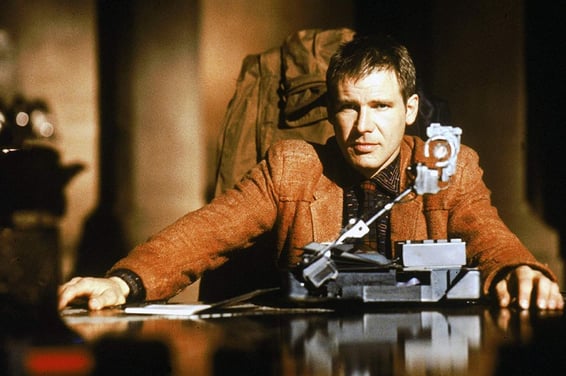Neon Dreams and Dystopian Realities: The Timeless Elegance of Blade Runner (1982)
Cinemapedia
Ridley Scott's Blade Runner (1982) is a cornerstone of science fiction cinema—a film that redefined the genre and established itself as a timeless classic. Adapted from Philip K. Dick's novel Do Androids Dream of Electric Sheep?, the movie explores a dystopian future where the line between human and machine is perilously blurred. Through its mesmerizing visuals, layered narrative, evocative music, and profound moral questions, Blade Runner remains an unparalleled masterpiece of storytelling and visual art.
A Vision of the Future Bathed in Neon and Shadows
Visually, Blade Runner is a groundbreaking achievement. The film’s aesthetic, often referred to as "tech-noir," combines elements of film noir with a futuristic dystopian vision. Set in a rain-soaked Los Angeles of 2019, the cityscape is dominated by towering skyscrapers, glowing neon advertisements, and perpetual darkness, creating a sense of claustrophobia and decay. Cinematographer Jordan Cronenweth’s masterful use of lighting and shadow brings the world to life, capturing both its beauty and its desolation.
The production design, led by Syd Mead, is equally stunning. The gritty streets teeming with life, the fusion of cultures and languages, and the retro-futuristic technology all contribute to a world that feels both fantastical and eerily plausible. The contrast between the opulence of Tyrell Corporation's golden pyramids and the grimy streets below underscores the film’s themes of inequality and exploitation. Every frame of Blade Runner is meticulously crafted, immersing the viewer in a world that is as visually rich as it is thematically complex.
A Noir-Tinged Exploration of Humanity
The narrative of Blade Runner is as much a philosophical inquiry as it is a detective story. The film follows Rick Deckard (Harrison Ford), a retired "blade runner" tasked with hunting down and "retiring" rogue replicants—bioengineered beings designed to serve humans. The story takes a turn when Deckard encounters Rachael (Sean Young), a replicant who believes herself to be human, and begins to question his own morality and identity.
The replicants, led by the enigmatic Roy Batty (Rutger Hauer), are not mere villains but tragic figures seeking freedom and purpose. Roy’s quest to confront his creator, Dr. Eldon Tyrell, serves as a poignant exploration of life, death, and the desire for meaning. The film’s climactic confrontation between Deckard and Roy culminates in one of cinema’s most iconic monologues—Roy’s "Tears in Rain" speech, a moment of profound beauty and humanity that leaves an indelible mark on the viewer.
Blade Runner weaves a complex web of themes, from the ethics of creating artificial life to the nature of memory and identity. Its noir influences are evident in Deckard’s morally ambiguous character, the femme fatale archetype embodied by Rachael, and the pervasive atmosphere of distrust and corruption. The story invites the audience to grapple with questions that have no easy answers, making it a film that lingers in the mind long after the credits roll.
The Ethereal Sound of a Dystopian Future
Vangelis’ score for Blade Runner is as iconic as the film itself. The music, a blend of haunting synthesizers and melancholic melodies, perfectly complements the film’s visuals and themes. The opening sequence, accompanied by the majestic "Main Titles" theme, immediately transports the audience into the film’s dystopian world.
The score oscillates between grand, sweeping compositions and intimate, emotional pieces, mirroring the film’s balance between its epic scope and its deeply personal story. Tracks like "Blade Runner Blues" evoke a sense of longing and melancholy, while "Tears in Rain" underscores the poignancy of Roy Batty’s final moments. Vangelis’ music is not merely an accompaniment but an integral part of the film’s emotional and atmospheric impact, elevating it to a transcendent cinematic experience.
What Does It Mean to Be Human?
At its core, Blade Runner is a meditation on the nature of humanity. The film challenges the viewer to consider what defines a person: Is it our biology, our memories, or our capacity for empathy? The replicants, though artificial, display emotions, desires, and a yearning for life that are undeniably human. In contrast, many of the human characters, including Deckard, exhibit coldness and detachment, blurring the line between creator and creation.
Roy Batty’s journey is particularly poignant. As a being with a limited lifespan, his desperation to extend his life resonates deeply, reflecting the universal human fear of mortality. His final act of sparing Deckard’s life is a moment of profound grace and humanity, suggesting that the capacity for compassion and selflessness transcends the boundaries of biology.
The film also raises ethical questions about the exploitation of artificial life. The replicants are created to serve and are denied basic rights, treated as disposable tools rather than sentient beings. Blade Runner serves as a cautionary tale about the consequences of playing god and the moral responsibilities that come with creating life.
A Timeless Reflection on Humanity
Blade Runner is more than just a film—it is a work of art that continues to inspire and provoke thought decades after its release. Ridley Scott’s vision, combined with Jordan Cronenweth’s cinematography, Vangelis’ evocative score, and the nuanced performances of its cast, creates a cinematic experience that is as emotionally resonant as it is visually stunning.
The film’s exploration of identity, memory, and morality remains as relevant today as it was in 1982. In a world increasingly shaped by artificial intelligence and technological advancements, Blade Runner serves as a reminder of the importance of empathy, self-reflection, and the search for meaning.
As the rain falls and the neon lights flicker, Blade Runner invites us to look inward, to question what it means to be human, and to find beauty in the fleeting moments of our existence. It is a film that dreams of electric sheep and awakens the soul.


